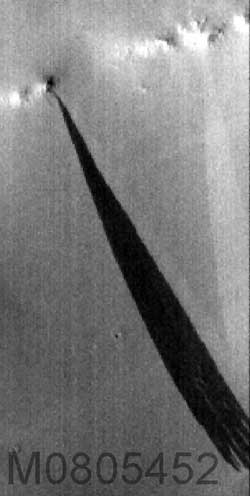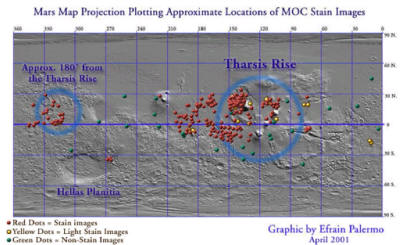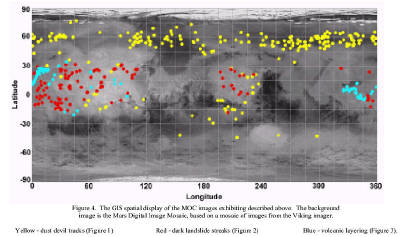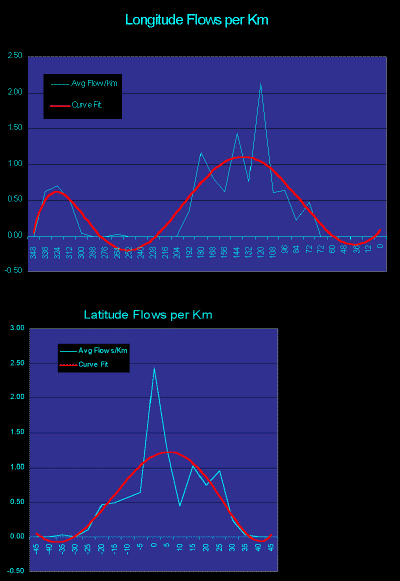Independent
Analysis of
Stain Distribution Pattern Confirms
Key Aspect of Tidal Model of Mars
Two recent papers distributed on the Internet by scientists at Brown University and the Georgia Institute of Technology (and presented at the 32nd annual Lunar and Planetary Institute Science Conference) have provided independent confirmation of a key aspect of the Mars "Tidal Model" we published a few weeks ago. The papers, which were presented at the conference in March of 2001, closely parallel the work of Jill England and Effrain Palermo, who presented their own paper at the recent Mars Society conference in Palo Alto, California.
All the papers deal with the "dark slope streaks," as they are referred to in the LPI papers, or "stains" as we have called them since the first time we presented our theory that they are liquid water flows back in July, 2000. England and Palermo showed in their paper that the distribution of the flows was bi-modal -- 180 degrees apart -- and centered around two "volcanic uplifts," the Tharsis and Arabia bulges.

It was this key distribution pattern which led us to propose our model that a former orbital lock tidal relationship between Mars and another planet caused the uplifts. We also argued that this pattern of distribution strongly implied they were in fact water stains from a former Martian ocean, not "dust streaks," as all the conventional papers have argued up till now. What these new papers show is that not only is Palermo and England's work replicable, but that the notion of these streaks as "dust" is starting to breakdown.
The first paper, presented by M. K. Rifkin and J. F. Mustard of the Brown University Dept. of Geologic Sciences, maps the distribution of several different types of "geologic features" found in a study of over eight thousand high-res MOC images. The distribution graph that they created (below right) shows that the bi-modal distribution pattern holds true.
 |
Graphics showing stain image distribution pattern from England and Palermo (left) and Brown University study (right). Stain images are in red in both graphs (note: longitudes are incorrect in Brown graphic).
This completely independent study, by a major university and also, like England and Palermo's paper, in the "literature," shows that the bi-modal stain image distribution is statistically accurate. While the Brown paper makes no attempt to explain the bi-modal distribution, it does show that England and Palermo's original work, upon which our tidal model is based, is valid.
There simply is no viable model -- other than our Tidal one -- which can explain this selective distribution of stains. Like Palermo and England's work, this Brown paper also failed to find any stain images in the upper latitudes (even though they searched there). This single, now confirmed fact completely devastates the "dust slide" model, since there is no reason that such wind driven dust slides would be confined to the equatorial regions. Conversely, if we, England and Palermo are correct, then a restriction of "water seep" images to the warmer equatorial regions is an outright requirement.
The second paper is a study of six "dark slope streaks" on the floor of the Cassini Impact Basin. It is also consistent with the bi-modal distribution pattern, as this area is within the regions showing stain patterns as mapped in the two studies mentioned above. This paper takes a slightly different tack, attempting to explain the seepages as Co2 mixing with "dust" to create the dark colored flows. This ad-hoc explanation might hold up in the absence of the now established bi-modal distribution pattern, but there is flatly no reason why Co2 bursts would be entrained to these two specific areas (the Tharsis and Arabia uplifts) if that model was valid. However, the simple acknowledgement that a source of some sort of "flow material," in this case Co2, is required to explain the seeps is a step in the right direction, even if the Co2 idea is silly. At least this paper doesn't try to pretend that this is nothing more than a dust slide.
Further confirmation has been found by Jill England. Below is a sample graph from a work-in-progress follow-up paper that she and Effrain Palermo are compiling.
In this current study, England has counted specific flows in 168 stain images (about half the total stain images she and Palermo have found) in an effort to determine a "flows per kilometer" pattern. What the preliminary results have shown is that not only are the flows truly bi-modally distributed to a high degree of precision, but the number of flows peaks around two specific longitudes. Her data shows that the longitudinal center points of the two highest flows per kilometer clusters are at 138° and 320°, almost exactly 180° apart!
So this pattern is anything but random, and has now been independently confirmed. The question now is how much longer will it be before the scientific community begins to take seriously the only theory which can explain it?

